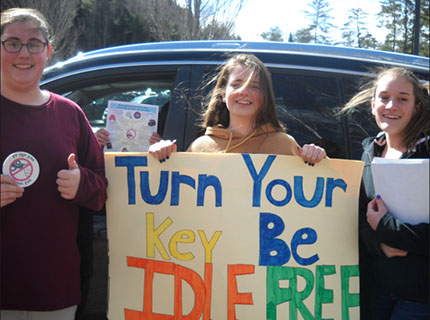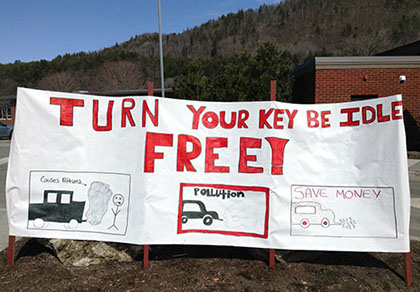Vermont Idle-Free Schools Archive
While today, Green Driving America is implementing Schools Are Not Drive-Thrus idle-free schools studies/campaigns, the organization was founded as Idle-Free VT in the State of Vermont in 2006. One of the organization's specialties then—as now—was raising awareness of unnecessary vehicle idling, including in the school community, chiefly around the harm and waste of prolonged, largely unnecessary passenger vehicle idling during the 15- to 30-minute dismissal period.
Idle-Free VT implemented funded idle-free schools projects: student-led measured studies/campaigns with the participation of 12 schools in Vermont between 2014 and 2016, and in 2023. Archives of these efforts show that the 2014 to 2016 campaigns reduced idling by approximately 36% overall. Among these schools combined, fuel consumption was reduced by 509 gallons and CO2 emissions by 10,180 lbs. (five tons).
PARTICIPATING SCHOOL: 2023
Funded by a New Hampshire foundation that wishes to remain anonymous.
Participating school and campaign result:
Woodstock Union High School and Middle School
SHORT-TERM, ONE-STEP MEASURED STUDY/CAMPAIGN
WOODSTOCK UNION HIGH SCHOOL & MIDDLE SCHOOL, Woodstock
Mountain Views Supervisory Union
Earth Beat club - Advisor: Kat Robbins, place-based education coordinator
Step 1: introductory session conducted 10/12/23
Step 2: Data collection conducted for three days at school afternoon dismissal on 10/17, 10/18, 10/19
Average temperature: 57 degrees
Total vehicles observed: 86; total vehicles idling: 41 (47%); total minutes/hours of idling: 282/4.7
Amount of fuel consumed*: 2.021 gal/three days / 0.67 gal/per day average
Amount of fuel consumed annually (est.) - based on 175 day school year: 117 gal
Amount of CO2 emissions annually (est.) - based on 175 day school year: 2,345 lbs**
Step 3: school supports idle-free study/campaign: Principal's Corner Newsletter - 11/5
Step 4: driver contact event: 12/4
COMMENTS: Kat Robbins on the driver contact event: "We talked to 22 drivers and all were receptive to our messaging. Students reported
that it wasn't that hard once they practiced a little and that they actually enjoyed it!"
As of 12/7, the school had not installed the provided idle-free zone signs, though the school's buildings and grounds dept. plans to do so
soon.
12/8: School provided information on how to sustain the idle-free effort in future years and the option of adopting a school idle reduction
policy/practice/measure.
*Amount of fuel consumed based on passenger vehicle — car/SUV/pickup truck — idling consumption of 0.43 gal/hr.
**Amount of CO2 emitted based on one gallon of fuel consumed equaling 20 pounds of CO2 emitted (gasoline - 19.64 pounds; diesel -
22.38 pounds)
The Vermont Standard article in January 18, 2024 issue: WUHS/MS conducts an idle-free school campaign

PARTICIPATING SCHOOLS: 2015-2016
Funded by the High Meadows Fund and the Vermont Community Foundation
Participating schools and study/campaign results:
Hunt Middle School • Lyndon Town School • Main Street Middle School • Shelburne Community School •
Stowe Middle School
FIVE SCHOOLS PARTICIPATING IN MEASURED STUDIES/CAMPAIGNS COMBINED TO REDUCE IDLING BY 41%1

Lyndon Town School
driver contact event, March 2016

Shelburne Community School
driver contact event, March 2016
SHELBURNE COMMUNITY SCHOOL, Shelburne
Co-leaders/teachers: Lisa Phelps, Science; Peg Rosenau, Advisor
Students: Winton team 8th grade science class and Environmental Club
Step 1: introductory sessions conducted 9/16 & 10/7
Step 2: initial data collection conducted for five days at school afternoon dismissal on 10/14, 10/15, 10/16, 10/21,
10/28
Average temperature: 53º
Total vehicles observed: 450*; total vehicles idling: 90* (20%); total minutes of idling: 1,180 = 19.7 hours
Amount of fuel consumed: 8.4 gal/five days / 1.7 gal/per day average
Amount of fuel consumed annually (est.) - based on 180 day school year: 306 gal (263 gallons relative to number of
vehicles observed, initial vs final measuring)
Amount of CO2 emissions annually (est.) - based on 180 day school year: 6,102 lb
Step 3: school announces idle-free study/campaign (Dec.-Jan.): Story published in Burlington Free Press. Story published
in Shelburne News.
Step 4: driver contact event on 3/14 & 3/16 IMAGE 1 IMAGE 2 IMAGE 3 IMAGE 4 IMAGE 5 IMAGE 6 SCS March
Newsletter The Tarrant Institute for Innovative Education at the University of Vermont created THIS VIDEO of the school's
Idle-Free team in action as it conducted a driver contact event
Step 5: final data collection conducted for four days at school afternoon dismissal on 4/27, 4/28, 4/29, 5/3
Average temperature: 50º
Total vehicles observed: 387; total vehicles idling: 38 (9.9%); total minutes of idling: 213 = 3.55 hours
Amount of fuel consumed: 1.52 gal/four days / .38 gal/per day average
Amount of fuel consumed annually (est.) - based on 180 day school year: 68 gal (195 gallon reduction relative to
number of vehicles observed, initial vs final measuring)
Amount of CO2 emissions annually (est.) - based on 180 day school year: 1,368 lb (3,892 lbs. reduction relative to number
of vehicles observed, initial vs final measuring)
BEFORE & AFTER IDLING DIFFERENCE: 74% REDUCTION1
*Estimated. Two pick up areas monitored. 8th grade science class and Environmental Club split observation/
measuring time. A sixth day of observations was eliminated due to a
number of drivers shutting off engines upon realizing idling data was being collected.

LYNDON TOWN SCHOOL, Lyndonville
Leader/teacher: Travis Courser, Science
Students: 8th grade science class
Step 1: introductory session conducted 9/21
Step 2: initial data collection conducted for four days at school afternoon dismissal on 10/26, 10/27, 10/28, 10/29
Average temperature: 47 degrees
Total vehicles observed: 70; total vehicles idling: 36 (51%); total minutes of idling: 415 = 7 hours
Amount of fuel consumed: 3.01 gal/four days / 0.75 gal/per day average
Amount of fuel consumed annually (est.) - based on 180 day school year: 135 gal (166 gallons relative to number of
vehicles observed, initial vs final measuring)
Amount of CO2 emissions annually (est.) - based on 180 day school year: 2,700 lb
Step 3: school announces idle-free study/campaign (Dec.-Jan.): letter, pledge form to parents; LTS Middle School
Newsletter (pg. 5)
Step 4: driver contact event on 3/22 & 3/24 IMAGE1 IMAGE2 IMAGE3
4/15: LTS MAGIC 97.7 RADIO INTERVIEW ABOUT CAMPAIGN-AUDIO IMAGE FROM INTERVIEW
Step 5: final data collection conducted for three days at school afternoon dismissal on 5/17, 5/18, 5/19
Average temperature: 59 degrees
Total vehicles observed: 86; total vehicles idling: 18 (21%); total minutes of idling: 98 = 1.6 hours
Amount of fuel consumed: 1.15 gal/three days / 0.38 gal/per day average
Amount of fuel consumed annually (est.) - based on 180 day school year: 69 gal (97 gallon reduction relative to number
of vehicles observed, initial vs final measuring)
Amount of CO2 emissions annually (est.) - based on 180 day school year: 1,380 lb (1,940 lbs. reduction relative to number
of vehicles observed, initial vs final measuring)
BEFORE & AFTER IDLING DIFFERENCE: 58% REDUCTION1

Lyndon Town School Idle-Free Schools campaign interview on Magic 97.7 Lyndonville, VT, April 15, 2016
HUNT MIDDLE SCHOOL, Burlington
Leader/teacher: Rebecca Reese, After School Program Director, and Michael Fasy, Paraeducator
Students: 7th grade Environmental Club
Step 1: introductory session conducted 9/22
Step 2: initial data collection conducted for four days at school afternoon dismissal on 10/6, 10/8, 10/13, 10/15
Average temperature: 63 degrees
Total vehicles observed: 92; total vehicles idling: 26 (28%); total minutes of idling: 73 = 1.22 hours
Amount of fuel consumed: .525 gal/four days / 0.13 gal/per day average
Amount of fuel consumed annually (est.) - based on 180 day school year: 24 gal (21 gallons relative to number of vehicles
observed, initial vs final measuring)
Amount of CO2 emissions annually (est.) - based on 180 day school year: 460 lb
Step 3: school announces idle-free study/campaign (Dec.-Jan.): campaign publicized - pg. 2 in HMS December Newsletter
Step 4: driver contact event on 4/4-8 week IMAGE1 IMAGE2 IMAGE3 IMAGE4
Step 5: final data collection conducted for four days at school afternoon dismissal on 5/17, 5/18, 5/23, 5/24
Average temperature: 73 degrees
Total vehicles observed: 81; total vehicles idling: 10 (12%); total minutes of idling: 66 = 1.1 hours
Amount of fuel consumed: .473 gal/four days / 0.12 gal/per day average
Amount of fuel consumed annually (est.) - based on 180 day school year: 21 gal (0 gallon reduction relative to number of
vehicles observed, initial vs final measuring)
Amount of CO2 emissions annually (est.) - based on 180 day school year: 420 lb (0 lbs. reduction relative to number of
vehicles observed, initial vs final measuring)
BEFORE & AFTER IDLING DIFFERENCE: 0%1
NOTE: Initial findings surprisingly minimal amount of idling. Final findings can be due to: A. ten degree increase in temperature which can
result in engines running for air conditioning; B. number of vehicles idling decreased from 28% in initial to 12% in final indicating skewing of
results due to prolonged idling by a few vehicles (to run air conditioning?). Final findings still reflect a minimal amount of idling.
MAIN STREET MIDDLE SCHOOL, Montpelier
Co-leaders/teachers: Amy Kimball, Math and science; Don Taylor, Language arts and social studies
Students: 7th & 8th grade Team Summit Green Team
Step 1: introductory session conducted 10/5
Step 2: initial data collection conducted for five days at school afternoon dismissal on 1019, 10/20, 10/21,
10/22,10/23
Average temperature: 49.4º
Total vehicles observed: 108; total vehicles idling: 61 (58%); total minutes of idling: 295 = 4.9 hours
Amount of fuel consumed: 2.11 gal/five days / 0.42 gal/per day average
Amount of fuel consumed annually (est.) - based on 180 day school year: 76 gal (43 gallons relative to number of
vehicles observed, initial vs final measuring)
Amount of CO2 emissions annually (est.) - based on 180 day school year: 1,517 lb
Step 3: school announces idle-free study/campaign (Dec.-Jan.): students presented data and next steps at school
assembly 12/23/15; flyer
sent home to parents and to school staff
Step 4: driver contact event on 3/28, 3/29, 3/30 IMAGE 1 IMAGE 2 IMAGE 3 IMAGE 4; Parent conference 4/1 IMAGE
Step 5: final data collection conducted for four days at school afternoon dismissal on 4/11, 412, 4/13, 4/14
Average temperature: 43.5º
Total vehicles observed: 61; total vehicles idling: 22 (36%); total minutes of idling: 89 = 1.5 hours
Amount of fuel consumed: 0.64 gal/four days / 0.16 gal/per day average
Amount of fuel consumed annually (est.) - based on 180 day school year: 29 gal (14 gallon reduction relative to number
of vehicles observed, initial vs final measuring)
Amount of CO2 emissions annually (est.) - based on 180 day school year: 576 lb (280 lbs. reduction relative to number of
vehicles observed, initial vs final measuring)
BEFORE & AFTER IDLING DIFFERENCE: 33% REDUCTION1

STOWE MIDDLE SCHOOL, Stowe
Leader/teacher: Ann Ndione, Science
Students: 7th & 8th grade Green Team
Step 1: introductory session conducted 10/8
Step 2: initial data collection conducted for four days at school afternoon dismissal on 10/15, 10/16, 10/19, 10/20
Average temperature: 45º
Total vehicles observed: 79; total vehicles idling: 46 (58%); total minutes of idling: 212* = 3.53* hours
Amount of fuel consumed: 1.52 gal/four days / 0.38 gal/par day average
Amount of fuel consumed annually (est.) - based on 180 day school year: 68 gal (56 gallons relative to number of
vehicles observed, initial vs final measuring)
Amount of CO2 emissions annually (est.) - based on 180 day school year: 1,367 lb
Step 3: school announces idle-free study/campaign (Dec.-Jan.): school idling information - pg. 3 in Dec. 2015 issue of
SMS Raider Review
Step 4: driver contact event on 4/12 & 4/13 IMAGE 1 IMAGE 2
Step 5: final data collection conducted for four days at school afternoon dismissal on 5/17, 5/18, 5/19, 5/23
Average temperature: 61º
Total vehicles observed: 65; total vehicles idling: 13 (21%); total minutes of idling: 104 = 1.73 hours
Amount of fuel consumed: 0.75 gal/four days / 0.19 gal/par day average
Amount of fuel consumed annually (est.) - based on 180 day school year: 34 gal (22 gallon reduction relative to number
of vehicles observed, initial vs final measuring)
Amount of CO2 emissions annually (est.) - based on 180 day school year: 671 lb (440 lbs. reduction relative to number of
vehicles observed, initial vs final measuring)
BEFORE & AFTER IDLING DIFFERENCE: 39% REDUCTION1
*Time is estimated as students were not able to stay until the last cars left - believed to be a low estimate. Also, once parents noticed kids
collecting data (even though they told adults nothing specific) many turned off their cars.

1 calculation based on reduction (or increase) in fuel consumed relative to number of vehicles observed - best overall formula based on variables in number of vehicles in initial vs final measurements. Based on this calculation, the five schools completing the study combined to reduce idling by 41%. Over a 180 day school year, this correlates to a fuel consumption reduction of 329 gallons and a C02 emissions reduction of 6,560 pounds. Although unmeasurable, there is also an indirect impact beyond the schools as hundreds of drivers were shown the benefits of idling reduction.
NOTE: Amount of fuel consumed based on passenger vehicle — car/SUV/pickup truck — idling consumption of 0.43 gal/hr. Amount of CO2 emitted based on one gallon of fuel consumed equaling 20 pounds of CO2 emitted (gasoline - 19.64 pounds; diesel - 22.38 pounds)
PARTICIPATING SCHOOLS: 2014-2015
Funded by the High Meadows Fund
Participating schools and study/campaign results:
Champlain Valley Union High School • Essex Middle School • Hartford High School •
Middlebury Union High School • St. Albans City School • South Royalton School
SIX SCHOOLS PARTICIPATING IN MEASURED STUDIES/CAMPAIGNS COMBINED TO REDUCE IDLING BY 31%1

South Royalton School
(now White River Valley High School)
driver contact event, April 2015

St. Albans City School
driver contact event, March 2015
HARTFORD UNION HIGH SCHOOL, White River Junction
Leader/teacher: Roy Hathorn, mathematics
Student leaders: Morgan and several other students
Step 1: initial training session conducted 9/24
Step 2: initial data collection conducted for five days at school afternoon dismissal on 10/6, 10/7, 10/8, 10/9, 10/10
Average temperature: 61º
Total vehicles observed: 94; total vehicles idling: 57 (61%); total min of idling: 513 = 8.55 hr
Amount of fuel consumed: 3.68 gal/five days / 0.73 gal/per day average
Amount of fuel consumed annually (est.) - based on 180 day school year: 132 gal (131 gallons relative to number of
vehicles observed, initial vs final measuring)
Amount of CO2 emissions annually (est.) - based on 180 day school year: 2,560 lb
Step 3: idling awareness letters sent to HHS parents; school website to announce idle-free study/campaign
Step 4: driver contact event on 4/2 & 4/3 IMAGE 1 IMAGE 2 IMAGE 3
Step 5: final data collection conducted for five days at school afternoon dismissal on 5/4, 5/5, 5/6, 5/7, 5/8
Average temperature: 82º
Total vehicles observed: 93; total vehicles idling: 17 (18%); total min of idling: 73 = 1.21 hr
Amount of fuel consumed: 0.52 gal/five days / 0.10 gal/per day average
Amount of fuel consumed annually (est.) - based on 180 day school year: 19 gal (112 gallon reduction relative to number
of vehicles observed, initial vs final measuring)
Amount of CO2 emissions annually (est.) - based on 180 day school year: 367 lb (2,240 lbs. reduction relative to number of
vehicles observed, initial vs final measuring)
BEFORE & AFTER IDLING DIFFERENCE: 85% REDUCTION1
COMMENTS: most successful outcome. Note for initial measurements, total vehicles idling (and therefore percentage of vehicles idling) is an estimate.

ST. ALBANS CITY SCHOOL, St. Albans
Leader/teacher: Josie Weldon, facilitator - Team USA
Step 1: initial training session conducted 11/12
Step 2: initial data collection conducted for four days at school afternoon dismissal on 11/12, 11/13,
11/14, 11/17
Average temperature: 41º
Total vehicles observed: 57; total vehicles idling: 44 (77%); total min of idling: 295 = 4.91 hr
Amount of fuel consumed: 2.11 gal/four days / 0.53 gal/one day average
Amount of fuel consumed annually (est.) - based on 180 day school year: 95 gal (137 gallons relative to number of
vehicles observed, initial vs final measuring)
Amount of CO2 emissions annually (est.) - based on 180 day school year: 1,868 lb
Step 3: Leader/teacher and student team spreading word of study/campaign in school community
Step 4: driver contact event on 3/24, 3/25, 3/26 IMAGE1 IMAGE2
Step 5: final data collection conducted for three days at school afternoon dismissal on 4/14, 4/31, 5/20
Average temperature: 54º
Total vehicles observed: 82; total vehicles idling: 47 (57%); total min of idling: 185 = 3.07 hr
Amount of fuel consumed: 1.32 gal/two days / 0.44 gal/per day average
Amount of fuel consumed annually (est.) - based on 180 day school year: 79 gal (58 gallon reduction relative to number
of vehicles observed, initial vs final measuring)
Amount of CO2 emissions annually (est.) - based on 180 day school year: 1,580 lb (1,160 lbs. reduction relative to number of vehicles observed, initial vs final measuring)
BEFORE & AFTER IDLING DIFFERENCE: 58% REDUCTION1
COMMENTS: initial measurements conducted four days; final measurements conducted three days

CHAMPLAIN VALLEY UNION HIGH SCHOOL, Hinesburg
Leader/teacher: Katie Antos-Ketcham, EnACT club advisor
Student leaders: Rachel and other students
Step 1: initial training session conducted 9/29
Step 2: initial data collection conducted for four days at school afternoon dismissal on 10/20, 10/21, 10/23, 10/24
Average temperature: 49º
Total vehicles observed: 95; total vehicles idling: 52 (55%); total min of idling: 347 = 5.78 hr
Amount of fuel consumed: 2.49 gal/four days / 0.62 gal/per day average
Amount of fuel consumed annually (est.) - based on 180 day school year: 112 gal
Amount of CO2 emissions annually (est.) - based on 180 day school year: 2,200 lb
Step 3: announcement of idle-free study/campaign in CVU EnACT Stall News
Step 4: driver contact event on 3/23, 3/24, 3/25 IMAGE 1 IMAGE 2
Step 5: final data collection conducted for three days at school afternoon dismissal on 5/11, 5/12, 5/13
Average temperature: 67º
Total vehicles observed: ___; total vehicles idling: ___ (35%); total min of idling: ___ = ___ hr
Amount of fuel consumed: ___ gal/three days / ___ gal/per day average
Amount of fuel consumed annually (est.) - based on 180 day school year: _____ gal
Amount of CO2 emissions annually (est.) - based on 180 day school year: _____ lb
BEFORE & AFTER IDLING DIFFERENCE: 36% REDUCTION1
COMMENTS: initial measurements conducted four days; final measurements conducted three days. Percentage of final total vehicles idling reduction confirmed; most other final measurements, including fuel consumption, unavailable from school.

ESSEX MIDDLE SCHOOL, Essex Junction
Leader/teacher: Lindsey Halman, facilitator - The Edge Academy Team
Adult support from Jim Cardillo
Step 1: initial training session conducted 10/3
Step 2: initial data collection conducted for five days at school afternoon dismissal on 10/27, 10/28, 10/29,
10/30, 10/31
Average temperature: 55º
Total vehicles observed: 111; total vehicles idling: 67 (60%); total min of idling: 426 = 7.10 hr
Amount of fuel consumed: 3.05 gal/five days / 0.61 gal/per day average
Amount of fuel consumed annually (est.) - based on 180 day school year: 110 gal (74 gallons relative to number of vehicles
observed, initial vs final measuring)
Amount of CO2 emissions annually (est.) - based on 180 day school year: 2,156 lb
Step 3: idle-free study/campaign and initial data collection in ETSD PTO news; campaign information in EMS parent
newsletter; campaign details included in EMS Whole School Energy Challenge report
Step 4: driver contact event on 3/31, 4/1, 4/2 IMAGE 1 IMAGE 2 IMAGE 3
Step 5: final data collection conducted for four days at school afternoon dismissal on 5/5, 5/6, 5/7, 5/8
Average temperature: 65º
Total vehicles observed: 75; total vehicles idling: 39 (52%); total min of idling: 183 = 3.05 hr
Amount of fuel consumed: 1.31 gal/four days / 0.33 gal/per day average
Amount of fuel consumed annually (est.) - based on 180 day school year: 59 gal (15 gallon reduction relative to number
of vehicles observed, initial vs final measuring)
Amount of CO2 emissions annually (est.) - based on 180 day school year: 1,159 lb (300 lbs. reduction relative to number
of vehicles observed, initial vs final measuring)
BEFORE & AFTER IDLING DIFFERENCE: 20% REDUCTION1
COMMENTS: initial measurements conducted five days; final measurements conducted four days. Following the campaign, the students gave a presentation on vehicle idling facts and their school campaign findings before the Essex Town School District school board: IMAGE 1 IMAGE 2 IMAGE 3

SOUTH ROYALTON SCHOOL (now White River Valley High School), South Royalton
Leader/teacher: Bill Goldsworthy, mathematics/science/technology
Students: Kat, Eleanor, Tyler, Meagan, Joseph
Step 1: initial training session conducted 10/6
Step 2: initial data collection conducted for five days at school morning drop off and afternoon dismissal on
10/20, 10/21, 10/22, 10/23, 10/24
Average temperature: 45º
Total vehicles observed: 688; total vehicles idling: 498 (72%); total min of idling: 439 = 7.31 hr
Amount of fuel consumed: 3.15 gal/five days / 0.63 gal/per day average
Amount of fuel consumed annually (est.) - based on 180 day school year: 142 gal (61 gallons relative to number of vehicles
observed, initial vs final measuring)
Amount of CO2 emissions annually (est.) - based on 180 day school year: 2,784 lb
Step 3: SRS idle-free study/campaign study and idling facts in 2/12 online weekly school newsletter, and emailed and sent hardcopy to all school parents
Step 4: driver contact event on 4/3 & 4/5 IMAGE 1 IMAGE 2 IMAGE 3
Step 5: final data collection conducted for four days at school morning drop off and afternoon dismissal on 4/28,
4/29, 4/30, 5/1
Average temperature: 50º
Total vehicles observed: 297; total vehicles idling: 235 (79%); total min of idling: 180 = 3.00 hr
Amount of fuel consumed: 1.30 gal/four days / 0.32 gal/per day average
Amount of fuel consumed annually (est.) - based on 180 day school year: 58 gal (3 gallon reduction relative to number
of vehicles observed, initial vs final measuring)
Amount of CO2 emissions annually (est.) - based on 180 day school year: 1,160 lb (60 lbs. reduction relative to number
of vehicles observed, initial vs final measuring)
BEFORE & AFTER IDLING DIFFERENCE: 5% REDUCTION1
COMMENTS: initial measurements conducted five days; final measurements conducted four days. 75-80% of So. Royalton School
measurements conducted during morning drop off. This caused their study to be misguided (fault of project director, not teacher). Prolonged idling tends to occur during afternoon pick up as parents typically arrive before dismissal. Morning drop off idling is brief - typically limited to under a minute; it is unrealistic to expect engines to be shut off and restarted in this short period. Indeed, So. Royalton School's final afternoon measurements showed a significant reduction in idling. All other schools conducted all measurements during afternoon pick up.

MIDDLEBURY UNION HIGH SCHOOL, Middlebury
Leader/teacher: Jay Harrington, mathematics/science
Students: James, Julia, Sully, Harriet, Chris, Kyle, Claire
Step 1: initial training session conducted 11/10
Step 2: initial data collection conducted for four days at school afternoon dismissal on 11/11, 11/12, 11/13, 11/14
Average temperature: 55º
Total vehicles observed: 142; total vehicles idling: 61 (43%); total min of idling: 190 = 3.17 hr
Amount of fuel consumed: 1.36 gal/four days / 0.34 gal/per day average
Amount of fuel consumed annually (est.) - based on 180 day school year: 61 gal (45 gallons relative to number of vehicles
observed, initial vs final measuring)
Amount of CO2 emissions annually (est.) - based on 180 day school year: 1,202 lb
Step 3: announcement of idle-free study/campaign in MUHS January 2015 school newsletter
Step 4: driver contact event on 3/17, 3/19 IMAGE
Step 5: final data collection conducted for four days at school afternoon dismissal on 5/11, 5/12, 5/13, 5/14
Average temperature: 65º
Total vehicles observed: 105; total vehicles idling: 34 (32%); total min of idling: 161.5 = 2.69 hr
Amount of fuel consumed: 1.16 gal/four days / 0.29 gal/per day average
Amount of fuel consumed annually (est.) - based on 180 day school year: 52 gal (7 gallon increase relative to number
of vehicles observed, initial vs final measuring)
Amount of CO2 emissions annually (est.) - based on 180 day school year: 1,023 lb (140 lbs. increase relative to number
of vehicles observed, initial vs final measuring)
BEFORE & AFTER IDLING DIFFERENCE: 16% INCREASE1
COMMENTS: lowest amount of idling in initial measurements. Final results skewed significantly by relatively low number of vehicles idling excessively as reflected in reduction of percentage of idling but increase in fuel consumed relative to number of vehicles observed. Also, 10 degree higher temperature average in final measuring could have contributed to increased use of A/C.

1 calculation based on reduction (or increase) in fuel consumed relative to number of vehicles observed - best overall formula based on variations in number of vehicles in initial vs final measurements. Based on this calculation, the six schools completing the study combined to reduce idling by 31%. Over a 180 day school year, for the five schools having complete data (excepting CVUHS), this correlates to a fuel consumption reduction of 181 gallons and a C02 emissions reduction of 3,620 pounds. This is a conservative figure based on So. Royalton School misguided study. Although unmeasurable, there is also an indirect impact beyond the schools as hundreds of drivers were shown the benefits of idling reduction.
NOTE: Amount of fuel consumed based on passenger vehicle — car/SUV/pickup truck — idling consumption of 0.43 gal/hr. Amount of CO2 emitted based on one gallon of fuel consumed equaling 20 pounds of CO2 emitted (gasoline - 19.64 pounds; diesel - 22.38 pounds)
Principal & Teacher comments
"This was a great activity for our students, from a research process/data collection standpoint and from a social change standpoint. The students who participated have a much deeper understanding of the effects of idling on air quality."
Dean Sterns, principal, South Royalton School (now White River Valley High School)
"The Vermont Idle-Free Schools project was incorporated into my STEM class for freshman and sophomores. My students gained a great deal of confidence working on this project. Students took it seriously and had generated many ideas that would allow them to show their work. They were highly engaged and took on the project as their 'job'. I believe this was a very beneficial project not only for the students, but for the school and community as well."
Bill Goldsworthy, teacher, South Royalton School (now White River Valley High School)
"Running the idling awareness campaign especially helped increase student awareness of the negative impact of idling as well as the magnitude of the problem at our school and in our communities. Idle Free Vermont provided organized, timely logistical and educational support on this project, which made it easy to coordinate at the school level. The student leaders found collecting data using the Smartphone app easy and engaging."
Katie Antos-Ketcham, high school teacher and EnACT team leader, Champlain Valley Union High School
"The Vermont Idle Free Schools program is an amazing learning activity for middle grades. Its project-based approach was extremely effective for our students. I watched Team USA members light up as they exercised their creativity, enthusiasm, as well as organizational, analytical and communication skills around the topic of idling. They received instruction, but also ran an experiment and public advocacy campaign. Team USA students walked away from the Idle Free Vermont project with memorable learning about a topic important to their lives, new real-world skills, as well as experience and pride in executing a job, and making a positive difference in their community. I highly recommend the project to other middle school teams!"
Josephine Weldon, middle school teacher and Team USA leader, St. Albans City School
"The Idle-Free campaign fit perfectly with our project-based learning approach on the Edge Academy Team at Essex Middle School. The students had identified car idling as a problem two years ago, and with the support of Wayne Michaud, began to research the impact of car idling on the health of our community. Once they developed their driving questions, the process guided the students to become leaders in the effort to create change in our community. Through data collection, sharing of results and presentations, the students gained many new skills, as well as created change in our community - a 20% reduction in idling! We hope to continue these efforts during the 2015-2016 school year."
Lindsey Slan Halman, Facilitator, The Edge Academy, Essex Middle School
